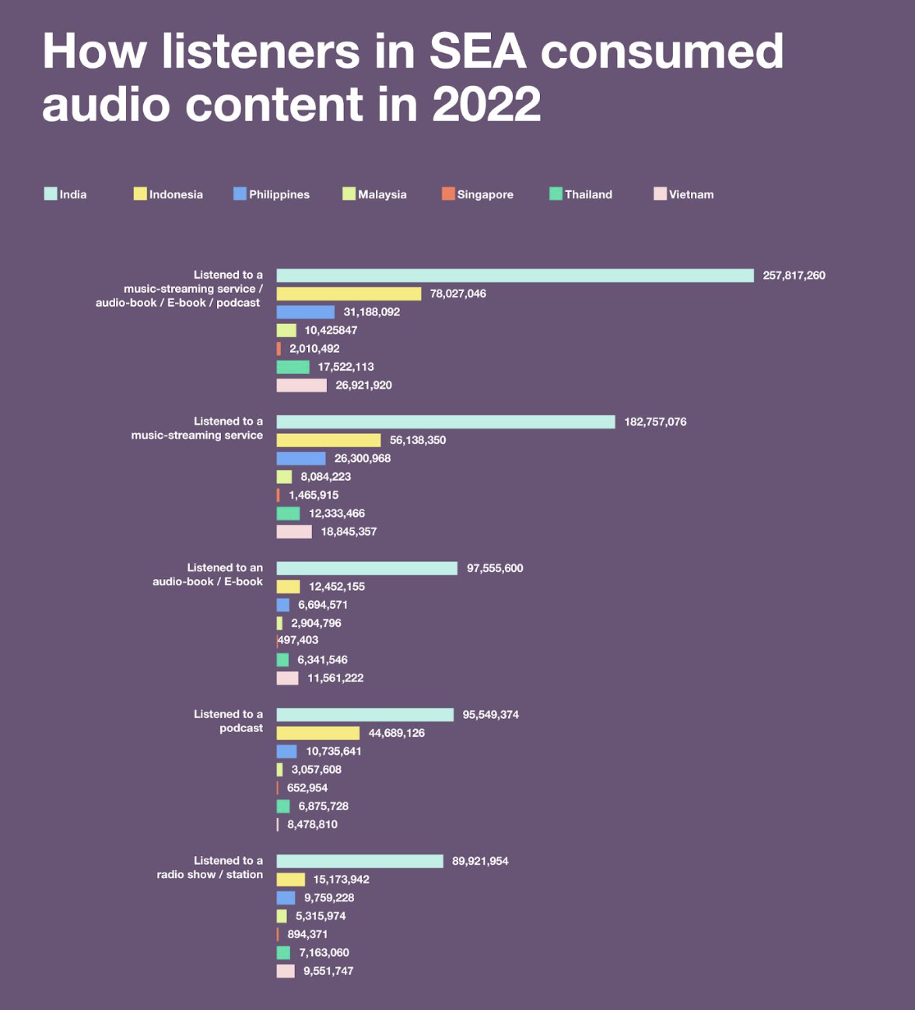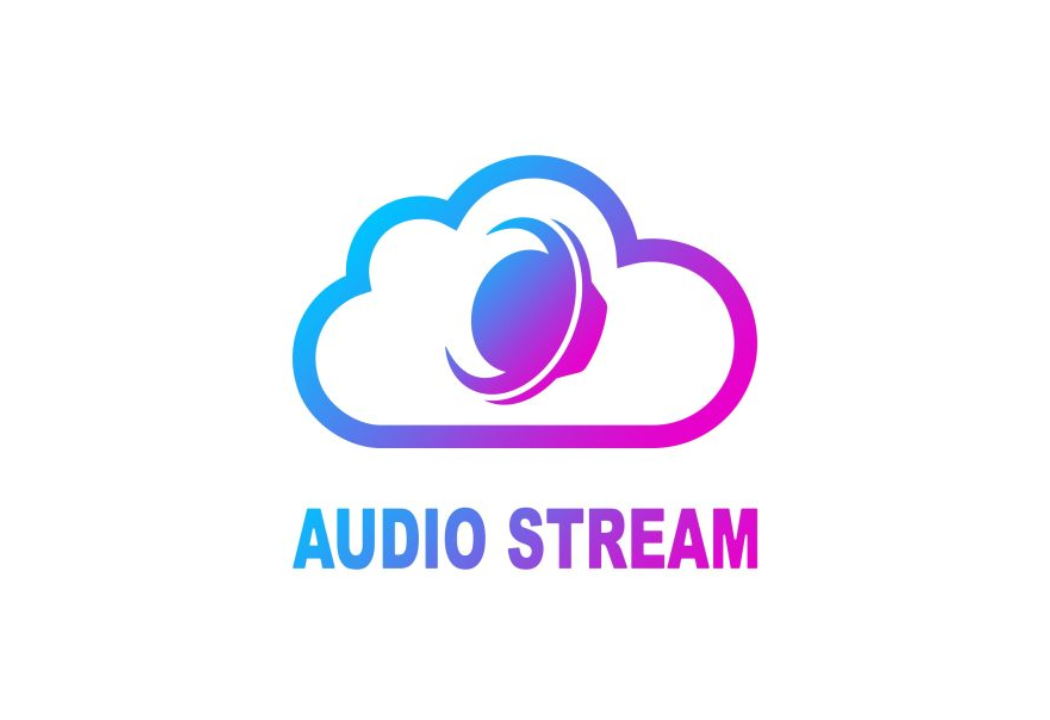
White Paper | Author: Yvonne Lau, Spotify
Audio streaming and advertising landscape in Asia – An overview
Audio as a media format is not new. In fact, radio was the first mass medium for communication, even before television. But the introduction of the Internet has surfaced a host of different media consumption habits over the years, leaving little room for audio until recent times.
Asia has seen the fastest growth for internet penetration over the past 10 years, at 67.4% in 2022, alongside the global average rate of just under 71%. With this growth, there has been a new rise in overall video and audio streaming. In India, for example, people are streaming music 19.1 hours a week, higher than the global average of 17.8 hours. Across Asia, the music and video streaming markets are estimated to surpass 50 billion US dollars in revenue in the next few years, showing great potential in the industry.
With audio advertising in the region projected to reach US$8.46bn this year, and the number of digital audio listeners increasing to 866.5 million by 2027, the future of audio is no longer limited to music, podcasts and audiobooks. This shouldn’t come as a surprise, as people around the world interact with one another by talking and listening on social platforms in real-time. For advertisers, this means that a wealth of opportunities now lie in audio.
Reaching millions of listeners across Asia
Unlike video or print, audio is a unique platform. It is highly engaging, yet allows the listener to be involved in other activities simultaneously, such as commuting, working out, even daily chores like cooking or cleaning. The ease of access, and versatility of this media format has made it an integral part of people’s everyday life. At Spotify, the number of monthly active users in APAC continues to grow month on month, with listeners using our platform as a “lean back” media at home, as well as tune in “on the go” while they’re out commuting.
The podcast format in particular has taken off in Asia with China leading the way as the second country with the most podcast listeners in the world, followed by India. Alongside the rise of smartphone ownership in APAC, 66% of people are podcast listeners, with the majority being from Indonesia. This is a move away from the constant scrolling on social media feeds, that have led to negative health implications.
Meanwhile, to cater to the social media generation, who have a higher preference for short-form content, content like podcasts and audiobooks have quickly become a preferred medium, as they are much more easily consumed compared to reading books. In many ways, audiobooks have bridged the gap between the Gen Z population and the classic novels the generation before them used to read.

Source: GWI
How can advertisers get creative and relevant with audio
More than being an engaging media, audio streaming is also a very intimate experience as people are often plugged in, instead of listening on speaker. Advertisers who take advantage of this deep connection that listeners have with their audio devices are able to leverage the emotional aspect of the audio format, playing with various types of sounds that can have profound effects on people’s thoughts and emotions.
To really reach audiences in an impactful way, advertisers should think outside the box and get creative with a variety of audio formats that can seamlessly interact with other marketing collateral. Programmatic audio is most effective with connected media campaigns, where audio ads are followed by banner ads in display. One example is placing an ad for a sustainable product on a sustainability podcast, then following up with a display banner on that same topic on a relevant site where the listener is likely to see.
A research by Spotify reveals that 93% of the brain’s engagement with content on Spotify is transferred directly into ad engagement. Consider how different genres evoke different emotions, and choose the best genres to reach your specific target audience. So if you’re a fitness brand, a great place to advertise is with a fitness podcast, or even within a fitness playlist. When people are working out, they are less likely to have much of an agenda on their mind, which can make them more receptive to an ad around the latest sports gear that could elevate their gym experience.
Reaching people at the right time of day through OOH ads that are seamlessly integrated into the world is one way advertisers can stay relevant, such as promoting food delivery services during rush hour, when people are most likely in a hurry to get home and prepare dinner for their families. By partnering with existing OOH sites, brands can learn more about their customers to further personalise their content over time for better ad recall.

The role audio plays for marketers
Audio can amplify a brand’s message in ways that other forms of marketing like display ads may not be able to do. This is because audio speaks to listeners, quite literally. However, knowing your target audience is key to successful audio advertising and marketing. With a clearly defined target audience, marketers can reach people on a much more personal level, even connect with niche audiences.
Audio can also be a highly engaging “theatre of the mind” media, whereby sound effects, music and voices are used to create an immersive sensory experience. It has the power to create an atmosphere that exudes suspense or tension, or puts the listener in a light, joyful mood. It can influence thought and evoke emotions or bring back memories.
What the industry can do to support audio
It’s been proven that audio format has become one of the most effective mediums for advertising, due to its immersive nature. Yet, only a fraction of marketing budgets are spent in audio. This means that a lot of potential customers that could come through the audio marketing funnel remain untapped, which is a big loss for brands.
To find real success in audio, it needs to be incorporated from the beginning, into the marketing or communication brief and media plan. Audio shouldn’t be an add on, or an afterthought, rather it should be integrated into the full marketing strategy. Integrated media campaigns are one way to look at this, at the very least, create a plan for audio advertising so that there is follow-through. How will listeners take action upon listening to an ad on their audiobook? How do you get listeners to convert the moment an ad piques their interest?
Working with creative agencies to figure out a strategy, or come up with creative and effective audio copy that encapsulates listener’s attention can be a start. People love a good conversation. Consumers want excitement, they want to hear something that surprises them, or evokes an emotion.
Then there’s the challenge of managing budgets. As audio is not yet a commoditised media, agencies need to be able to exercise some flexibility within their budgets to allow for new ways to experiment with audio. From customised live audio streams to programmatic automation for ad placements these findings will result in more concrete approaches over time that will lead brands who are willing to take the risk stand out among their competitors.
Driving long-term change
To make the most of audio streaming as an effective advertising landscape, brands should integrate audio advertising in their programmatic strategy with DSPs and agencies. As a whole, the ad industry can do more to measure the effectiveness of audio as a key channel on media plans. This will help grow audio as an effective platform, generating wider reach and building top of mind awareness.
Ultimately, it is an ecosystem that will drive long-term change and success for advertisers. Users are already across different media platforms and are consuming content across channels. It’s up to brands and advertisers to seize this opportunity and make the most of it.

